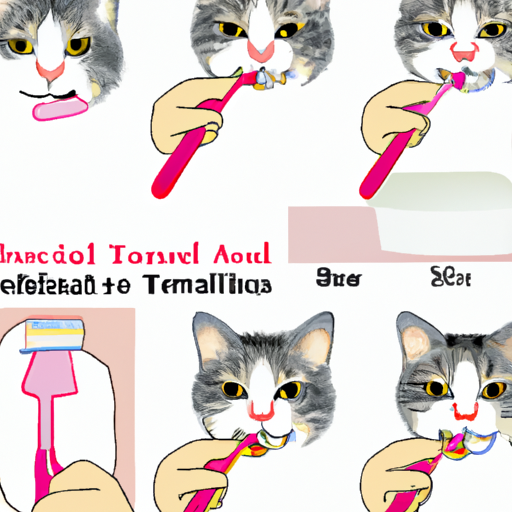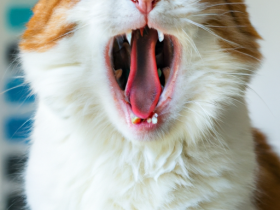“Keep Your Cat’s Pearly Whites Healthy with Proper Dental Care!”
Introduction
Cats are known for their independent nature, but that doesn’t mean they don’t need regular care and maintenance. One important part of your cat’s health is dental care. Brushing your cat’s teeth is an important part of maintaining their dental health. It can help prevent plaque buildup, bad breath, and other dental issues. In this article, we’ll discuss how to brush a cat’s teeth and other tips for maintaining their dental health.
The Benefits of Brushing Your Cat’s Teeth: How to Get Started
Brushing your cat’s teeth is an important part of their overall health and wellbeing. Regular brushing can help to prevent the buildup of plaque and tartar, which can lead to gum disease and other dental problems. It can also help to reduce bad breath and keep your cat’s teeth looking and feeling healthy.
Getting started with brushing your cat’s teeth can seem daunting, but it doesn’t have to be. Here are some tips to help you get started:
1. Choose the right toothbrush and toothpaste. It’s important to use a toothbrush and toothpaste specifically designed for cats. Human toothbrushes and toothpaste can be too abrasive for cats and can cause irritation.
2. Make it a positive experience. Start by getting your cat used to having their mouth touched. Offer treats and praise when they allow you to touch their mouth.
3. Start slow. Begin by brushing just one or two teeth at a time. Gradually increase the number of teeth you brush each session.
4. Use a gentle touch. Use slow, gentle strokes when brushing your cat’s teeth. Don’t press too hard, as this can cause discomfort.
5. Reward your cat. Offer treats and praise after each brushing session to reinforce the positive experience.
By following these tips, you can help to ensure that brushing your cat’s teeth is a positive experience for both you and your pet. Regular brushing can help to keep your cat’s teeth healthy and strong, and can help to prevent dental problems in the future.
The Best Cat Toothbrushes and Toothpastes for Optimal Dental Health
Good dental health is essential for cats, just as it is for humans. Unfortunately, cats are not always the best at taking care of their teeth, so it is important to provide them with the right tools to do so. The best cat toothbrushes and toothpastes can help keep your cat’s teeth and gums healthy and free of plaque and tartar.
When it comes to toothbrushes, there are a few different types to choose from. Soft-bristled toothbrushes are best for cats, as they are gentle on their gums and teeth. Finger brushes are also a great option, as they are easy to use and can help you get to those hard-to-reach places. If your cat is particularly resistant to brushing, you may want to try a toothbrush designed specifically for cats, which has a longer handle and a smaller head.
When it comes to toothpaste, there are a few different types to choose from. Cat toothpastes are specially formulated to be safe for cats and are usually flavored with chicken or fish to make them more palatable. You should also look for toothpastes that contain enzymes to help break down plaque and tartar. Additionally, look for toothpastes that contain fluoride to help strengthen your cat’s teeth.
Finally, it is important to brush your cat’s teeth regularly. Brushing at least twice a week is recommended, but more frequent brushing is even better. If your cat is resistant to brushing, you may want to try brushing their teeth with a small amount of toothpaste on your finger. This can help them get used to the sensation of having their teeth brushed.
By providing your cat with the right tools and brushing regularly, you can help keep their teeth and gums healthy and free of plaque and tartar. With the right toothbrush and toothpaste, you can help ensure your cat has a healthy smile for years to come.
How to Introduce Your Cat to Tooth Brushing: Tips and Tricks
Tooth brushing is an important part of your cat’s overall health and wellbeing. Regular brushing can help to prevent plaque and tartar buildup, as well as reduce the risk of gum disease and other dental issues. However, introducing your cat to tooth brushing can be a challenge. Here are some tips and tricks to help make the process easier.
1. Start slow. Begin by introducing your cat to the toothbrush and toothpaste. Let them sniff and explore the items, and reward them with treats for their curiosity.
2. Make it a positive experience. Use a toothpaste that is specifically designed for cats, as it will have a flavor that they will enjoy. Also, use a soft-bristled brush and be gentle when brushing.
3. Use rewards. Offer your cat treats or a special toy after each brushing session to reinforce the positive behavior.
4. Make it a routine. Establish a regular brushing schedule and stick to it. This will help your cat become accustomed to the process.
5. Seek professional help. If your cat is still resistant to tooth brushing, consider taking them to a veterinarian or professional groomer for assistance.
By following these tips and tricks, you can help make the process of introducing your cat to tooth brushing easier and more enjoyable. With patience and consistency, your cat will soon be comfortable with the routine.
The Importance of Regular Dental Check-Ups for Cats
Regular dental check-ups are an important part of maintaining the health of cats. Just like humans, cats can suffer from dental problems such as periodontal disease, tooth decay, and gingivitis. These conditions can cause pain and discomfort, and can even lead to more serious health issues if left untreated.
A regular dental check-up is the best way to ensure that your cat’s teeth and gums remain healthy. During a dental check-up, your veterinarian will examine your cat’s teeth and gums for any signs of disease or infection. They may also take x-rays to check for any underlying issues. If any problems are found, your veterinarian can provide treatment to help prevent further damage.
In addition to a dental check-up, it is important to provide your cat with regular dental care at home. This includes brushing their teeth with a soft-bristled toothbrush and toothpaste designed specifically for cats. You should also provide your cat with dental treats and toys to help keep their teeth clean and healthy.
Regular dental check-ups and home care are essential for keeping your cat’s teeth and gums healthy. By taking the time to provide your cat with the necessary dental care, you can help ensure that they remain healthy and happy for years to come.
How to Spot Signs of Dental Disease in Cats and What to Do About It
Cats are prone to dental disease, and it is important to be aware of the signs and symptoms so that you can take action to protect your cat’s health. Dental disease in cats can range from mild to severe, and can cause pain, infection, and even organ damage if left untreated.
The most common signs of dental disease in cats are bad breath, yellow or brown tartar buildup on the teeth, and red or swollen gums. If your cat is exhibiting any of these signs, it is important to take them to the vet for a dental exam.
Your vet will be able to diagnose the severity of the dental disease and recommend a course of treatment. This may include a professional dental cleaning, antibiotics, or even tooth extraction.
In addition to professional treatment, there are steps you can take at home to help prevent dental disease in cats. Regular brushing with a soft-bristled toothbrush and toothpaste designed specifically for cats can help remove plaque and tartar buildup. You can also feed your cat a diet that is designed to help reduce plaque and tartar buildup.
Finally, it is important to keep an eye on your cat’s mouth for any signs of dental disease. If you notice any of the signs mentioned above, take your cat to the vet for a dental exam as soon as possible. Early detection and treatment can help prevent more serious complications from developing.
Q&A
Q1: How often should I brush my cat’s teeth?
A1: It is recommended to brush your cat’s teeth at least once a week. If your cat has a history of dental problems, you may need to brush more often.
Q2: What type of toothbrush should I use?
A2: It is best to use a toothbrush specifically designed for cats. These brushes are usually smaller and have softer bristles than regular toothbrushes.
Q3: What type of toothpaste should I use?
A3: You should use a toothpaste specifically designed for cats. Human toothpaste can be toxic to cats, so it is important to use a toothpaste specifically designed for cats.
Q4: How do I get my cat used to having their teeth brushed?
A4: Start by introducing your cat to the toothbrush and toothpaste. Let them sniff and explore the items before you start brushing. You can also give them treats while you brush to make the experience more enjoyable.
Q5: What other steps can I take to maintain my cat’s dental health?
A5: In addition to brushing your cat’s teeth, you should also provide them with dental chews and toys to help keep their teeth clean. You should also take your cat to the vet for regular dental check-ups.
Conclusion
Brushing your cat’s teeth is an important part of maintaining their dental health. It is important to use the right tools and techniques to ensure that your cat’s teeth are properly cleaned and cared for. With regular brushing, you can help your cat maintain healthy teeth and gums and prevent dental problems in the future.








Leave a Reply
View Comments